Involvement of Low Level Employees in Organization Strategy Planning and Implementation ()
1. Introduction
Common characteristics of an organization are goals, people and structure (Decenzo et al., 2013), an organization started with a purpose for establishment which is considered as the main long run strategic goal, for profitable organizations like banks, it is financial profit, where all other goals support directly or indirectly this goal. Successful implementation of a strategy will help a company to become progressing over time, which will help organization to reflect its vision and mission in a good way, and finally will lead to successful organization (Crittenden & Crittenden, 2008). Institutions established and work with an open-ended life, pursue to achieve the strategic goals.
Due to the lack of comprehensive framework of strategy implementation, institutions fail to link their strategic goals with the actual work in the field (Okumus, 2001). All employees in an institution shall work in line with their organization strategic plan and be directed from top to lower level in the hierarchy to work according to the vision, mission of their organization, the main issue we noticed in our daily life in different organizations that there is a deviation between strategic goals and annual plans. Noble said “there is a significant need for detailed and comprehensive conceptual model” (Noble, 1999), he added also that when an organization implements its strategy effectively, this will give a competitive advantage for that organization.
Strategy implementation is not that an easy process, and it is of a high concern for all teams in an organization because simply it converts what is written to actions, according to (Noble, 1999). “The best formulated strategies may fail to produce superior performance for the firm if they are not successfully implemented”.
In this paper, the researcher will discuss effect of low-level employees who are in the lower level of the hierarchy, generally they are doing the job and most of them have direct contact with the customers as in banking sector for example. According to (Liao & Subramony, 2008) customers are very important, and organization should keep relationships with them, give support and feedback as they have major input in marketing according to their reachability.
According to (Decenzo et al., 2013) stakeholders are groups in the external and internal environments, employees are the primary group, and they are main part for analysis in defining the strength of an organization.
This topic is selected because there are lacks of research discussing it, generally we found a lot of publications about strategy planning, formulation, implementation but without giving major attention to the role and effect of low-level employees. This research will discuss the link between top and low-level employees in the area of strategy planning, awareness and implementation as they are an important input for different types of tasks also they are the doers of all tasks assigned vertically through and organization hierarchy.
2. Literature Review
2.1. Strategy Issues
Figure 1, describes a strategic model which contains three main phases for any organization strategy; it starts with the question, where we are? Then where we want to be? And how to get there? (Bryson, 1988), details can be added to any of these phases but in general our mission, vision, resources, strength, etc. are simply. Strategy planning is an output for answering the question, how to get there? Many questions can be drilled down like what resources do we need? What is the needed budget? What are the tasks for each department and so on?
2.2. Strategic Planning
Strategic planning is an important phase for strategy formulation as it is a set of tools and guidelines and processes available to help top management to prepare the organization plan. Indeed, strategic planning may be defined as a “disciplined effort to produce fundamental decisions and actions that shape and guide what an organization” (Bryson & Roering, 1988), Strategies are often easier to formulate than implement (Coulson-Thomas, 2013). There some factors that if
![]()
Figure 1. The ABCS of Strategic Planning.
prepared and performed in the right will increase the efficiency of strategy implementation by developing applicable strategy, continuous and progressive review and enhancing of control systems (Rajasekar & Khoud, 2014), successful implementation engages all organizations’ resources like policies regulations, management competencies; so incorrect resources’ allocation will be a major obstacle for strategy implementing, this because implementation need resources from the whole organization as they were considered in the internal analysis for the strength of the organization (Jaakkola, Helkkula, & Aarikka-Stenroos, 2015).
2.3. Importance of Employees in Planning
An important resource for strategy planning are the employees (Idrovo Carlier, Costamagna, Mendi, & Parra, 2017; Lo & Fu, 2016), they shall be engaged; knowing that without them the best plans will worth nothing, because input should be gathered from all levels and from all employees regardless their position (Wheelen & Hunger, 2012), employees mean everyone in the organization not just the managers who are upper levels, it is known that the main responsibility for strategic planning is related to top management according to their role and involvement in the organization, but in the implementation phase all should be included and goals should be linked to organization strategy (Davis, Allen, & Dibrell, 2012). It follows that a critical for strategy implementation is that the people should be involved and their suggestions shall be considered, not just telling them what to do (Piercy, 2002; Ruck, Welch, & Menara, 2016). According to (Piercy, 2009) ownership and commitment gained when all employees involved in the implementation especially the key players who should be involved, this is called buy-in process.
2.4. Strategy Implementation
Strategy implementation is a process by transforming strategic goals to action items mapped to different organization stakeholders, these action items are formulated as projects which contain activities and assigned budget, this mapping will cause an overall change to the whole organizations actors (Wheelen & Hunger, 2012)
The engagement of employees in strategy implementation is so important as the are the doers and their engagement is important and critical to organization success (Kaliannan & Adjovu, 2015); businesses in which the general manager trust employees have higher lower turnover than do businesses in which there is a lesser amount of trust (Wheelen & Hunger, 2012). One of the things that emerges from the debate about implementation is that the “implementation capabilities”. “Which is the ability of people and organizations to get things done” (Piercy, 2009).
Through strategy implementation, many issues arose like transforming strategic plan into sub-plans and actions. There are resistance from the people, the systems and the procedures, the departments and the managers, whose involvement is, needed (Piercy, 2009), policy regulations, management competencies and the resource allocations determine successful implementation of the strategic plans. Inadequate resource allocations have a direct bearing on the implementation (Mason-Jones, 1999).
2.5. Engagement of Employees in Strategy Awareness and Implementation
Engagement itself is a strategy to manage employees efficiently by aligning their jobs to organization goals (Bailey, 2016; Idrovo Carlier et al., 2017), this agrees with the importance of linking strategic goals with organizational actors with varying degrees of responsibility that would participate in the realization and make tangible effort on organization success (Mercurio, Nito, & Iacono, 2014; Ruck et al., 2016). A well-implemented strategy should encompass all employees on all hierarchical levels of the organization. Previous research has been focused on senior managers or talent and strategy (Lengnick-hall & Lengnick-hall, 1988) and no enough attention has been placed on the link between human capital and strategy across hierarchies (Katou & Budhwar, 2015). A strategy should not be kept at management level because there are not the doers but managers should share the vision and mission of the organization, studies suggested effective communication between leaders and employees in an important factor on own employees engage in their job (Audenaert et al., 2017). According to (Liu, Ko, & Chapleo, 2017) communication will help employees to express their ideas about their workplace.
Strategy can be transformed to employees level by supported technical system using balanced scored card as example, these systems will help not for employees involvement but also for assigning, monitoring and controlling employees tasks (Lueg, 2015) and it allowed detailed breakdown and control for goals into action items that can be controlled for all employees and units in an organization (Jaakkola, Helkkula, & Aarikka-Stenroos, 2015).
Enhancing an organizational effectiveness through strategy implementation, institutions need to have visionary leaders who will enhance the attitude of innovation in the organizations (Palladan, Abdulkadir, & Chong, 2016).
One of the management models used to link the strategic goals to short-term Objectives is management by objectives (MBO) which is implemented after the corporate and business strategies and objectives are fully developed, communicated, and integrated, strategic goals will be translated to short-term, measurable, operating objectives within the acquired business (Hrebiniak, 2005), these objectives should be prioritize according to importance to organization strategy (Samagaio & Rodrigues, 2016). Another model is balanced scored card, which links financial and non-financial goals for all employees, and it is an known approach used to link strategy formulation and strategy implementation (Rasoolimanesh, Jaafar, Badarulzaman, & Ramayah, 2015), it breaks down large goals to smaller pieces in a measurement system, the provide the needed framework to control achievements for all levels and show that in the financial reporting system, some systems link this performance measurement to employees annual appraisal (Zizlavsky, 2014), it is considered better than MBO, as it provides a framework to translate strategy into operational terms (Hrebiniak, 2005; Zizlavsky, 2014).
3. Methodology
3.1. Study Objectives
The objective of this study is to find out how much the low-level employee are engaged in the strategic planning and implementation, for sure their tasks are mostly operational and they have minor role in planning and decision making but they have a major role in running the day-to-day job, they met customer’s and can observe their needs; they perform tasks on different IT systems, receive customers’ complains and other tasks.
This study will analyze how much low-level employees are informed about the vision, mission and strategic goals for their organizations, and how much their action plans derived from the strategic plan.
According to the findings a recommendation will declared according to the results, so it might be an input to organization who wishes to benefit from this research.
3.2. Research Questions
Tailored from the study objective this research will try to answer the main question.
“Are the low-level employees involved in strategy planning and implementation?”
In order to answer this question, I break it down to three questions, which will support formulating an answer, the questions are:
• Are they involved in strategy planning phase?
• Are they aware of the strategic plan?
• Are their plans linked and controlled according the strategic plan?
If we can answer these questions, then we can tell if they are involved in the strategic plan and they have an effect role in implementation.
The sub questions discuss lifecycle for a strategic plan which start with planning, collecting inputs from different stakeholders, define strength and weaknesses, opportunities and threats, and so on. After setting the strategic plan for an organization, which should include, the vision, the mission, the strategic. A plan should be circulated internally to all employees and externally to the customers via different channels, finally all departments and employee’s objectives should be linked to the strategic plan.
Thus research does not discuss the role of managers or departments, it discusses the role and involvement of low-level employees which they, in general, not involved, but they should circulate and announce the major component to all employees and for their customers. Finally, well-managed organization should link annual plans to the strategic plan
3.3. Hypothesis and Theoretical Framework
After conducting the literature review and interviews and set research questions the following theoretical frameworks designed to answer the questions of this research
Hypothesis:
• Are low-level employees involved in strategy planning phase?
o H0: low-level employees not involved in planning.
o Ha: low-level employees involved in planning
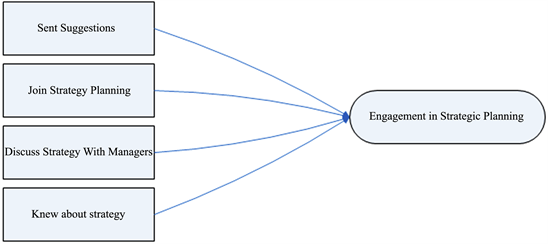
Schematic diagram for theoretical framework for engagement in Planning
• Are they aware of the strategic plan?
o H0: low-level employees not aware of the strategic plan.
o Ha: low-level employees aware of the strategic plan.
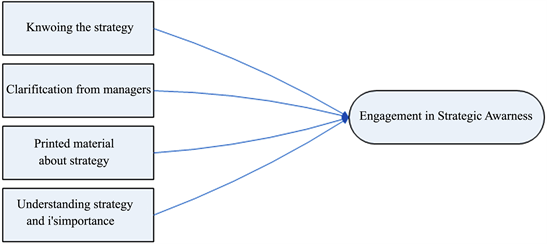
Schematic diagram for theoretical framework for engagement in Awareness.
• Are their plans linked and controlled according the strategic plan?
o H0: low-level employee’s plans not linked to the strategic plan.
o Ha: low-level employee’s plans linked to the strategic plan.
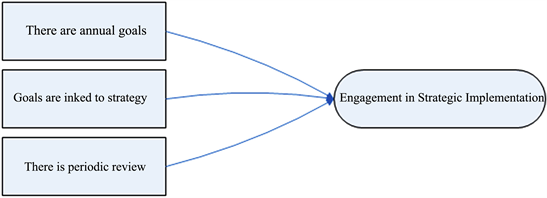
Schematic diagram for theoretical framework for engagement in Implementation.
3.4. Methodology
This is a descriptive research; the expected outcome is to describe the involvement of employees in strategy planning and implementation. There will be a concentration on the low-level employees but it general we need to understand the current situation and how strategy planned and implemented in organizations, to get the needed descriptive data the researcher collected it from primary and secondary sources.
Regarding the secondary sources an in-depth literature review performed from different international journals in addition to other books, the review described how strategy planned and implemented.
Primary data in two forms qualitative and quantitative sources. Qualitative collected through interviews with organizations managers. Quantitative date will collected via a questionnaire, which targeted different service organizations in Turkey and Palestine, selection of organizations according the ability to distribute surveys to its employees.
After collecting data it filled in a data file according to the questions herein this research then it analyzed using SPSS.
4. Data Collection
4.1. Population
The target population is banking sector employees (two banks). This segment selected because of my experience and the researcher have some connections in Turkey, also there are a lot of qualitative goals in the organizations strategic goals which can be hardly managed in the employee appraisal like, role of employee in customer satisfaction and social responsibility which considered strategic goals for an organization. Initially the researcher planned to target specific organization but he could not found a specific one that can disclose its name so he went for two Banks and they agree to share the survey with their employees.
4.2. Instrument
A sample questionnaire designed (Appendix 8) and verified, questionnaire check via SPSS, Cronbach’s alpha was 0.682, questions were clear and direct with no bias, there were analyzed and checked, also factor analysis used to compare the new scale with those used by other researches, accordingly the scales verified. Dichotomous and Likert scale answers required, there are no ambiguous words. There are two versions of the questionnaire English/Turkish, Hardcopy/Online.
The questions in the survey designed to support answering of the three minor questions about the engagement of low-level employees in planning, awareness, and the employees’ engagement in the strategy implementation.
4.3. Collection
The researcher visited the two banks and met the managers, discussed with them the research purpose and what they think about strategy planning and implementation.
Soft copy sent different employees via their managers (200 surveys). After two weeks (117) responses received, expected more but it seems there was no enough cooperation, mostly because end of year.
SPSS used to enter data, variables defined as ordinal, nominal according to the need, values assigned it each question to match the list of answers in the surveys.
Interviews conducted with managers from both banks at end of 2019.
4.4. Data Analysis and Finding
Managers declared that they engage all employees in strategy planning an implementation, they receive suggestions and discuss it with employees, they circulate all strategy outcomes to all employees, and they believe the importance of the strategy, some organization implemented software to control employee’s achievements and other do it via in-house templates but mostly the process goes manual.
117 responses were collected for surveys, there are responses from different management levels 54.7% from low-level management level, 24.8 from middle management and 20.5 from high management (See Appendix 1).
Questions were grouped according to the dependency between variables I have three dependent variables for the engagement of low-level employees (Planning, Awareness and Implementation), which show the correlation between the dependent variables and the management level.
The analysis show significance between management level and strategy planning (see Appendix 2) the significance mean, joining the strategy meeting, knowing when the strategy prepared, sending suggestions to their managers and if their managers discussed with them the strategic planning. 89% of the low-level employees were not engaged in the strategy planning as they answer (see Appendix 3).
The analysis show significance between management level and strategy Awareness, as if they knew their strategy, they knew the vision and mission, is there a printed material, their managers clarified to them the strategy and its importance (see Appendix 4). 63% of the low-level employees answered that they knew about their organization stagey which 29.9% can’t answer this question, 6% show that they don’t know anything about their organization strategy (see Appendix 5).
There is no significance between management level and strategy implementation as employees have annual goals and these goals linked to the strategy; also there is a periodical review for plan and goals (see Appendix 6). 54% of the low-level employees answers that they have goals and it is monitored, 23% show that there are goals but not linked totally to strategic goals and there is no periodical review, 22% of the low-level employees shown that their goals are not linked and there is no periodical review.
According to the collected and analyzed data, the researcher found that low-level employees are not engaged in the planning phase of the strategy, they knew the strategy and its importance but there was a big portion 37% who can’t tell if they know or they don’t know, this percentage is not small and should be considered by high and middle management.
Low-level employees are engaged in the strategy implementation as majority of them have annual goals that are linked to the strategic goals and their goals are periodically reviews with their managers.
From the interviews with managers they declared that the collect suggestions from all employees and conduct meetings with them, also they clarify organizations strategy and they do the needed effort to circulate the strategy to all employees.
5. Conclusion
Strategic plan is the most important document for the whole organizations as it reflects the vision, mission and goals for the next years, studies show that there is no enough knowledge about strategy implementation and so more researched in this area are needed (Okumus, 2001). Strategy planning and formulations considered they are easy jobs comparing to implementation which lasts for years (Coulson-Thomas, 2013).
In this research we can tell the services (Banking) sector organizations prepared strategic plans but did not engage low-level employees as well, also there is no enough efforts to circulate and clarify the strategy to all employees especially low-levels, which results in employee’s limitation of thinking about the place they work in, which will also form an obstacle in sharing their thoughts and suggestions to their top management that might be due to lower communication between different management levels and not enough listening to voice of employees, which is concluded also by (Ruck et al., 2016). Many low-level employees are in direct contact with the customers and so they should be considered in strategy planning and awareness in order to be fully integrated and coherent with a successful organization.
Positive point that low-level employees engage in strategy implementation as they have annual goals linked to the strategic goals and they have periodical review, organized did that with different approaches like Management by objectives (MBO) or balances scored cards, there are also software applications that help organization to set goals on organization level and map it down to lower levels.
Appendix 1
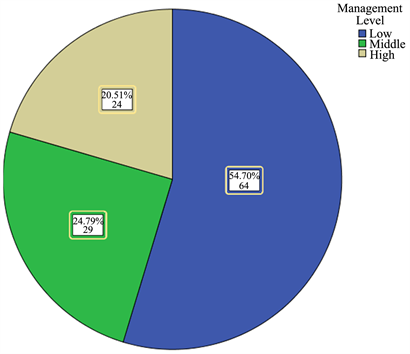
Appendix 2
**Correlation is significant at the 0.01 level (2-tailed).
Significance between management level and strategy planning
Appendix 3
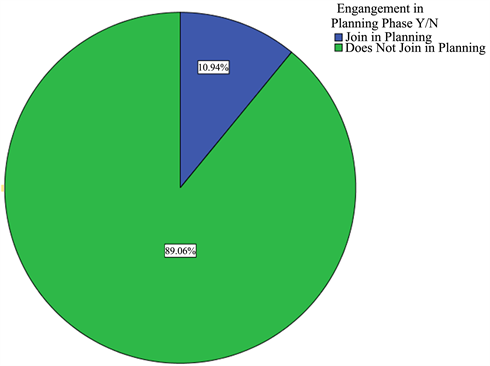
Appendix 4
**Correlation is significant at the 0.01 level (2-tailed).
Appendix 5
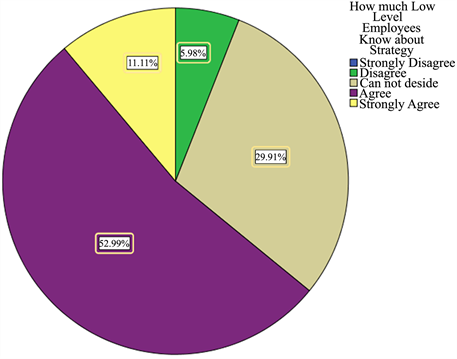
Appendix 6
Appendix 7

Appendix 8
Thank you.